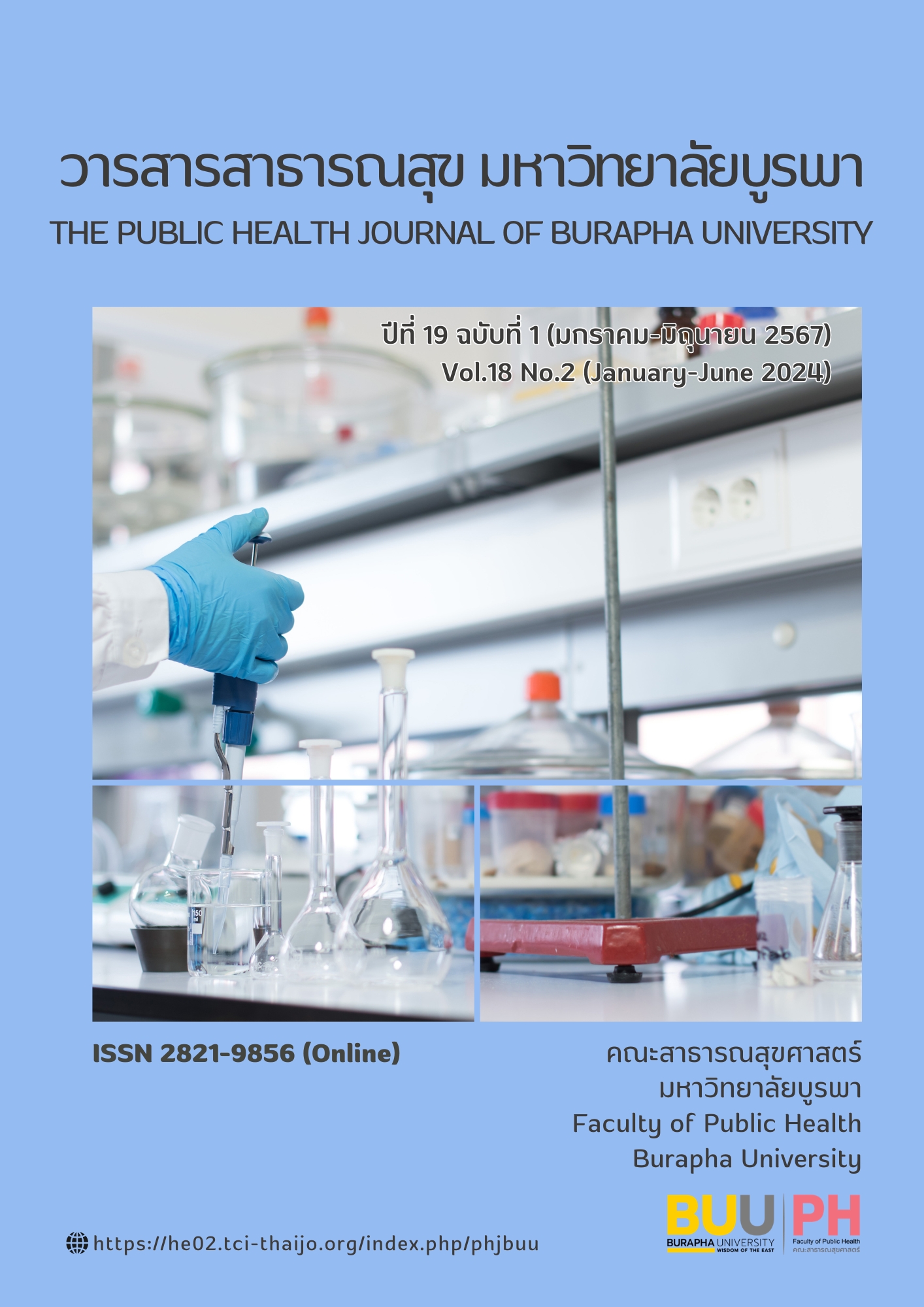การเพิ่มคุณภาพการนอนหลับโดยการใช้โปรแกรมการฝึกหายใจแบบใช้กะบังลมในพยาบาลวิชาชีพของโรงพยาบาลแห่งหนึ่งในจังหวัดชลบุรี
Main Article Content
บทคัดย่อ
การวิจัยกึ่งทดลองเพื่อศึกษาการเพิ่มคุณภาพการนอนหลับโดยการใช้โปรแกรมฝึกหายใจแบบใช้กะบังลมในพยาบาลวิชาชีพของโรงพยาบาลหนึ่งในจังหวัดชลบุรี กลุ่มตัวอย่างคือ พยาบาลวิชาชีพที่ปฏิบัติงานในแผนก
อายุรกรรม รวม 21 คน ผู้วิจัยสาธิตการฝึกหายใจแบบใช้กะบังลมและให้ปฏิบัติเป็นรายบุคคล มีคลิปสั้นและแผ่นพับ เก็บข้อมูลโดยการใช้แบบสอบถามเกี่ยวกับ ข้อมูลส่วนบุคคลและแบบประเมินคุณภาพการนอนหลับพิทส์เบอร์ก (PSQI) ฉบับภาษาไทย วิเคราะห์ข้อมูลด้วยสถิติเชิงพรรณนาและเปรียบเทียบค่าเฉลี่ยคะแนนคุณภาพการนอนหลับก่อนและหลังเข้าร่วมโปรแกรมที่ 2 และ 4 สัปดาห์ ด้วยสถิติ Wilcoxon signed rank test ที่นัยสำคัญทางสถิติ = .01
ผลการศึกษาพบว่า กลุ่มตัวอย่างส่วนใหญ่เป็นเพศหญิงร้อยละ 85.7 อายุเฉลี่ย 31.14 ปี มีปัญหาคุณภาพการนอนหลับเกินเกณฑ์มาตรฐานทั้งหมด ร้อยละ 100.0 มีค่าเฉลี่ย 8.71 คะแนน และหลังการเข้าร่วมโปรแกรมที่ 2 และ 4 สัปดาห์ พบว่ากลุ่มตัวอย่างร้อยละ 71.4 และร้อยละ 81.0 มีระดับคุณภาพการนอนหลับอยู่ในเกณฑ์มาตรฐาน มีค่าเฉลี่ย 4.56 คะแนน และ 4.18 คะแนน ตามลำดับ เมื่อเปรียบเทียบค่าเฉลี่ยคะแนนคุณภาพการนอนหลับก่อนและหลังการเข้าร่วมโปรแกรมที่สัปดาห์ที่ 2 และสัปดาห์ที่ 4 พบว่ามีความแตกต่างกันอย่างมีนัยสำคัญทางสถิติที่ระดับ 0.01 (p <.001 และ p <.001 ตามลำดับ) การศึกษานี้แสดงให้เห็นว่า โปรแกรมการฝึกหายใจแบบใช้กะบังลมสามารถเพิ่มคุณภาพการนอนหลับของพยาบาลวิชาชีพได้อย่างมีประสิทธิผล
Article Details

อนุญาตภายใต้เงื่อนไข Creative Commons Attribution-NonCommercial-NoDerivatives 4.0 International License.
เอกสารอ้างอิง
ดารัสนี โพธารส. ปัจจัยที่มีความสัมพันธ์กับคุณภาพการนอนหลับของนิสิตพยาบาล. วารสารคณะพยาบาลศาสตร์ 2560; 1, 25-36.
Hidaka, T., Kasuga, H., Endo, S., Masuishi, Y., Kakamu, T., Takeda, A., Fukushima, T. Are lifestyle pattern changes associated to poor subjective sleep quality?: a cross-sectional study by gender among the general Japanese population underwent specified medical check- ups in 2014 and 2015. BMJ Open 2020; 10(12), e037613. doi:10.1136/bmjopen-2020-037613
Shochat, T. Impact of lifestyle and technology developments on sleep. Nat Sci Sleep 2012; 4, 19-31. doi:10.2147/nss.S18891
กรมสุขภาพจิต. วันนอนหลับโลก ล้วงลึกปัญหา นอนไม่หลับ น่ากลัวแค่ไหน?. เข้าถึงได้จาก https://www.bangkokbiznews.com/social/926876. 2564
Perlis ML, Smith MT, Pigeon WR. Etiology and Pathophysiology of Insomnia. In Principles and Practice of Sleep Medicine. Elsevier Incorporated. 2005. p. 714-25.
Lichstein, K. L., McCrae, C. S., & Petrov, M. E. Insomnia: Epidemiology and risk factors. Elsevier. 2017.
Laugsand, L. E., Strand, L. B., Platou, C., Vatten, L. J., & Janszky, I. Insomnia and the risk of incident heart failure: a population study. Eur Heart J 2014; 35(21), 1382-1393. doi:10.1093/eurheartj/eht019
LeBlanc, E. S., Smith, N. X., Nichols, G. A., Allison, M. J., & Clarke, G. N. Insomnia is associated with an increased risk of type 2 diabetes in the clinical setting. BMJ Open Diabetes Res Care 2018.; 6(1), e000604. doi:10.1136/bmjdrc-2018-000604
Hertenstein, E., Feige, B., Gmeiner, T., Kienzler, C., Spiegelhalder, K., Johann, A., Baglioni, C. Insomnia as a predictor of mental disorders: A systematic review and meta-analysis. Sleep Med Rev 2019; 43, 96-105. doi:10.1016/j.smrv.2018.10.006
Daley, M., Morin, C. M., LeBlanc, M., Grégoire, J. P., & Savard, J. The economic burden of insomnia: direct and indirect costs for individuals with insomnia syndrome, insomnia symptoms, and good sleepers. Sleep 2009; 32(1), 55-64.
Lin, P. C., Chen, C. H., Pan, S. M., Chen, Y. M., Pan, C. H., Hung, H. C., & Wu, M. T. The association between rotating shift work and increased occupational stress in nurses. J Occup Health 2015; 7(4), 307-315. doi:10.1539/joh.13-0284-OA
เพชรสุนีย์ ทั้งเจริญกุล กฤษดา แสวงดี ตวงทิพย์ ธีระวิทย์ วิโรจน์ ตั้งเจริญเสถียร. ปัญหาสุขภาพและพฤติกรรมการดูแลสุขภาพของพยาบาลวิชาชีพในประเทศไทย. วารสารวิจัยระบบสาธารณสุข 2558 ;9(1) 49- 60.
Tsai HJ, Kuo TB, Lee GS, Yang CC. Efficacy of paced breathing for insomnia: enhances vagal activity and improves sleep quality. Society for Psychophysiological Research 2015; 52(3) : 388-96.
Yu X, Fumoto M, Nakatani Y, Sekiyama T, Kikuchi H, Seki Y, Sato-Suzuki I, Arita H. Activation of the anterior prefrontal cortex and serotonergic system is associated with improvements in mood and EEG changes induced by Zen meditation practice in novices. International Journal of Psychophysiology 2011; 80(2) : 103-11.
Cohen, J. Statistical power analysis for the behavioral sciences. New Jersey: Lawrence Erlbaum Associates. 1998.
Sitasuwan, T., Bussaratid, S., Ruttanaumpawan, P., & Chotinaiwattarakul, W. Reliability and validity of the Thai version of the Pittsburgh Sleep Quality Index. J Med Assoc Thai 2014; 97 Suppl 3, S57-67.
Liu Y, Jiang TT, Shi TY, Liu YN, Liu XM, Xu GJ, Li FL, Wang YL, Wu XY. The effectiveness of diaphragmatic breathing relaxation training for improving sleep quality among nursing staff during the COVID-19 outbreak: a before and after study. Sleep Medical Reviews 2021; 78(1): 8-14.
Blasche, G., Bauböck, V. M., & Haluza, D. Work-related self-assessed fatigue and recovery among nurses. Int Arch Occup Environ Health 2017; 90(2), 197-205. doi:10.1007/s00420-016-1187-6
Porta, A., Guzzetti, S., Montano, N., Pagani, M., Somers, V., Malliani, A., Cerutti, S. Information domain analysis of cardiovascular variability signals: Evaluation of regularity, synchronisation and co-ordination. Medical and Biological Engineering and Computing 2000; 38(2), 180-188. doi:10.1007/BF02344774
Harinath, K., Malhotra, A. S., Pal, K., Prasad, R., Kumar, R., Kain, T. C., .Sawhney, R. C. Effects of hatha yoga and omkar meditation on cardiorespiratory performance, psychologic profile, and melatonin secretion. J Altern Complement Med 2004; 10(2), 261-268. doi:10.1089/107555304323062257
Heminger, B., & Sheridan, D. J. Could melatonin be the cure for sleepless nights? Nursing 2022, 48(1).
Fadl, E., Khalik, A., Mohammad, M., Abd Elbaky, M., Ahmed, N., Hamza, S., & Moursy, T. The effectiveness of using breathing exercise on sleep quality among hospitalized patients. American Journal of Nursing Science 2000; 9, 272-280. doi:10.11648/j.ajns.20200904.28

